Zelda II: The Adventure of Link is a video game released in the 1980's, and is the
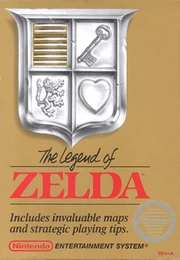
The Legend of Zelda
direct sequel to 1986's The Legend of Zelda game, released for the NES.
Hyrule[]
While certain landmarks of Hyrule commonly return, Hyrule's geography appears to be laid out
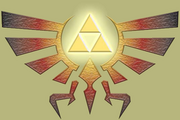
Hyrule Symbol
differently with almost every new game set in it. Parts of Hyrule found in one game's map may be in a different location, have different geographical features, or be completely absent in another. While some games may take into account the geography in past Zelda games (A Link to the Past and Four Sword Adventures share almost the same Hylian geography) others may completely ignore them (The Minish Cap's Hyrule bears almost no resemblance to any other game). Several fan explanations have been given. The first is that the changes occurred because of geological events between the games such as earthquakes, mudslides, erosion, forest growth, continental drift, or all of the above. The second theory is that Hyrule's geography stays relatively the same but that each new game shows the same Hyrule seen from a different angle, that landmarks are renamed, or that other unseen parts of Hyrule are seen each game. Some fans argue that while Hyrule does change from game to game it is simply due to gameplay
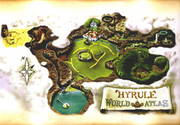
Hyrule Map
reasons to give players something new to explore while staying in the same land and has no real in-game explanations.
It is also possible that different parts of Hyrule are shown throughout the various games. In The Legend of Zelda comics, the map from Zelda II: The Adventure of Link is added to the north of the map found in The Legend of Zelda, and the in-game map for Zelda II: The Adventure of Link also has an area that resembles a scaled down version of the map in The Legend of Zelda. The geography then allows the map from A Link to the Past to be included to the west.
Sheikah[]
The Sheikah are first introduced in Ocarina of Time, but in The Legend of Zelda and Zelda II: The Adventure

of Link, there is a character called Impa, who is the attendant of Princess Zelda. There are no indications that this Impa is of the Sheikah race, owing to the fact that she does not have red eyes in the game's official artwork. This could be a case of retcon byNintendo, because there are certain similarities between Impa fromOcarina of Time and the one appearing in The Legend of Zelda andAdventure of Link. They both have considerable knowledge of Hyrule, Ganon and the Royal Family. thumb|left|link=Zelda II: The Adventure

of Link, there is a character called Impa, who is the attendant of Princess Zelda. There are no indications that this Impa is of the Sheikah race, owing to the fact that she does not have red eyes in the game's official artwork. This could be a case of retcon byNintendo, because there are certain similarities between Impa fromOcarina of Time and the one appearing in The Legend of Zelda andAdventure of Link. They both have considerable knowledge of Hyrule, Ganon and the Royal Family.
Alternatively, according to the Legend of Zelda timeline, the events of The Legend of Zelda and its sequel Zelda II: The Adventure of Link from the NES games, take place after the time line splits into three branches based upon the outcome of The Legend of Zelda: Ocarina of Time. If the Hero is defeated in The Legend of Zelda: Ocarina of Time then the next games in the time line are The Legend of Zelda: A Link to the Past, The Legend of Zelda: The Oracle of Ages, The Legend of Zelda: The Oracle of Seasons, The Legend of Zelda: Link's Awakening, then Zelda I and Zelda II. This could mean since the original NES games are the last in the game series' "defeated hero" time line, then the characteristic features of the Sheikah race of the red eyes and tanned skin, may have been lost over time by interbreeding with other races. It is already known that the characters of Zelda, Link, Impa, and others are not the same ones in all the games throughout the series. The Link in The Legend of Zelda: Ocarina of Time and The Legend of Zelda: Majora's Mask are the same in those two games, but it is not the same Link as the Link who appears in The Legend of Zelda: The Wind Waker and The Legend of Zelda: Phantom Hourglass, those each being the same Link in those two games, but at a much later time period (and a different/parallel timeline to the one cited above). As a result, the Impa that appears in the NES games, may not be a pure blooded Sheikah and therefore, possesses characteristics of both the Hylian race and the Sheikah race. As a result of her being a descendant of the Sheikah though, she still possesses the knowledge and training of the Sheikah people. We already know the Sheikah were a rare race in The Legend of Zelda: Ocarina of Time and naturally became even fewer over the period of time that followed. If the Sheikah and Hylian's were originally the same race that differed over time after a split between them occurred, it would be only natural for those characteristics distinguishing one from the other to merge and blend if they were joined back together at a later time.
Carock[]
Carock bears a striking resemblance to the Magician from the The Adventure of Link prologue.
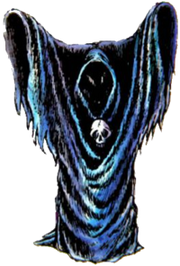
Carock
The Magician is never seen in-game, but there are pictures of him in the instruction manual for The Adventure of Link; these pictures greatly resemble Carock. Though nothing is ever mentioned about this, it is possible that the two share some kind of connection. The Magician himself, however, is explained to have died before the events of the game itself. However, it is possible he is simply the Magician brought back to life, since many of the enemies throughout the Legend of Zelda series are undead.
Death Mountain[]
"Take a good look at that mountain. That is Death Mountain, home of the Gorons." — Impa
Death Mountain (デスマウンテン Desu-Maunten?, Hylian DHylian EHylian AHylian THylian HHylian
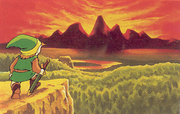
Death Mountain
SpaceHylian MHylian OHylian UHylian NHylian THylian AHylian IHylian N) is a recurring location in the Legend of Zelda series. A huge mountain or mountain range that is typically the highest geographical point of Hyrule, Death Mountain has become a well known location within the series, and serves as the homeland of the proud Goron race in most games. Occasionally, entry to Death Mountain is restricted; one must receive permission from the Royal Family of Hyrule to enter the mighty mountain. It is generally believed that the name Death Mountain is used for many different mountains in the series, but because some of its appearances share certain geographical or topographical similarities, some Death Mountains are believed to be one and the same.
Dragon Roost Island[]
It is believed that Dragon Roost Island, an island in The Legend of Zelda: The Wind Waker, is
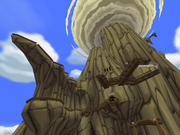
Dragon Roost Island
Death Mountain. Prior to the events of The Wind Waker, most of Hyrule was flooded and buried at the bottom of what came to be known as the Great Sea. However, the tall Death Mountain managed to stay above water. Gorons have long since left their traditional dwelling, disguising themselves as Traveling Merchants. Instead, the Rito race, a race confirmed to be descendants of the Zora, live here in dwellings cut into Dragon Roost Mountain. The first dungeon, Dragon Roost Cavern, is believed to be Dodongo's Cavern. Dragon Roost Island is not an active volcano like Death Mountain, but there is a small volcano directly south of it called Fire Mountain. Another fact that supports this theory is the existence of Bomb Flowers that grow in Dragon Roost Island as well as in Death Mountain.
Eldin Volcano[]
It is also widely believed that Eldin Volcano from The Legend of Zelda: Skyward Sword was later renamed Death Mountain, as it is the only mountainous area in the land that would eventually be known as Hyrule.
Hero's Clothes[]
Because the Link in The Legend of Zelda: Skyward Sword was the first hero chosen by the Gods,

Hero's Clothes
and the knights are seen wearing the Hero's Clothes, it is possible that this is where they originated from, and from this Link they have been passed down. It is more likely however, that the Hero of Time was the one who passed down the idea as shown in Wind Waker and Twilight Princess.
Iron Knuckles[]
In Ocarina of Time, if Link positions himself such that the camera moves just through the
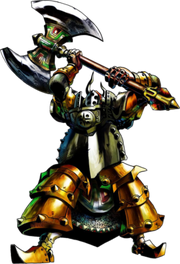
Iron Knuckle
vertices that compose an Iron Knuckle's helmet (and certain other pieces of armor), a Gerudo can be seen inside. Additionally, removing the enemy's top armour piece reveals a feminine figure. It is possible that these Gerudo were brainwashed by Koume and Kotake, just like Nabooru was, as both share the same vacant, wide-eyed stare. These Gerudo may also be seen when the same process is used in Majora's Mask; however, this may simply be a case of reused models. It is also possible that during development, the Iron Knuckles' helmets were meant to fall off during the second stage of the fight, revealing the person inside. Iron Knuckles also emit yells and grunts that sound distinctively male, but so does Nabooru's Iron Knuckle form, which could be the result of the acoustics within the armor(i.e. the sound of the wearer's voice bouncing off the insides of the suit, making it deeper in pitch).
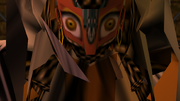
A Gerudo's face seen within an Iron Knuckle
Another

Underneath the enemy's top piece, a female physique can be seen
possibility is that the game designers used existing Gerudo 3D models as a template around which to base the Iron Knuckle design simply for convenience, and did not intend for Iron Knuckles to be seen as Gerudo. However, this seems unlikely, as the under-the-helmet appearance of regular Iron Knuckles is noticeably different from the mini-boss Iron Knuckle, Nabooru. If the game designers were opting for convenience, all Iron Knuckles would likely bear Nabooru's character model inside them. It is also possible that the designers did not want the identity of the Iron Knuckle fought as a mini-boss revealed earlier in the game.
Kasuto[]
It is likely that Kasuto is the town being attacked by Ganon's minions in the instruction booklet's prologue, which would explain why it is deserted during the game.
Link[]
Reincarnation[]
A common theory as to why each incarnation of Link looks similar and have similar abilities is
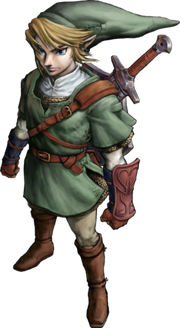
Link
that they are reincarnations of one another. It is notable that when Demise put a curse onto the Skyward Sword, Link, and Zelda, he stated "Those like you... Those who share the blood of the goddess and the spirit of the hero." which may have been referring to reincarnation. It should be noted however, that Link from The Wind Waker could not be the reincarnation of the Hero of Time since the latter went to the Child Timeline and effectively disappeared from the Adult Timeline. According to the King of Red Lions, the Hero of Winds has no connection to the Hero of Time, though it is unclear whether he is referring to blood relation or reincarnation with this statement. It is worth noting that Ganondorf believes the Hero of Winds is the Hero of Time reborn, though his claim has no concrete evidence. Link from Twilight Princess also could not be the reincarnation of the Hero of Time since, according to Hyrule Historia, he not only met the Hero of Time as the Hero's Shade, but is however his descendant.
Relatives[]
Another theory as to why each incarnation of Link looks similar to one another is that they are actually related to one another. This is supported by the fact that the Hero of Time is the ancestor of Link in Twilight Princess as well as how it is stated in A Link to the Past that the Master Sword can only be pulled out from its pedestal by the ones who carry the bloodline of the Knights of Hyrule. It is possible that when Demise stated "Those like you... Those who share the blood of the goddess and the spirit of the hero," when he put a curse on Link and Zelda, he was actually referring to the "spirit of the hero" as a form of will or a set of personality traits rather than the soul itself. If this is the case, this could explain each Link's connection with the Triforce as well as their abilities in physical, mystical, and spiritual ways.
This may mean when he was stating "Those who share the blood of the goddess" he was referring to Skyward Sword Link and Zelda's descendants as the other incarnation of Links rather than the Royal Family of Hyrule, where an alternate reason for the Royal Family having magical powers is the Light Force as hinted in The Minish Cap. This would explain why Link faces other adversaries aside from Ganon, with Zelda (or other members of the Royal Family) sometimes not being present to support the side of good in games such as as Majora's Mask, Link's Awakening and Tri Force Heroes The original Japanese text that Demise states is that his hatred and the Demon Tribe will go under an "evolution", which may mean the curse could involve other villains apart from Ganon himself.
If each Link is related to one another, they need not be related along a single line of descendants. For example, the Hero of Winds cannot be a direct descendant of the Hero of Time since the latter returned to the Child Timeline immediately after his victory over Ganon while being a young preteen in a teenager's body, but provided the Hero of Winds can trace his lineage to Skyward Sword Link, the theory still holds. It is possible that the reason why the Master Sword can only be pulled from it's pedestal by someone who carries the bloodline of the Knights of Hyrule is actually a sub-conscience decision by Fi, who is the spirit of the Master Sword.
Madas[]
It is possible that in the contemporary Hylian language during the events of Skyward Sword, Link's name may be "Madas" when pronounced. This would explain why Fi, when talking to Link in dialogue that uses his name, often says "Madi Madas" with "Madi" possibly being "Master" in the language. Alternatively, it is possible that Fi's words are gibberish used repetitively in the game, similar to Midna in Twilight Princess.
Lizalfos[]
The Lizalfos are probably related to a variety of other, similar, reptilian species. Lizalfos
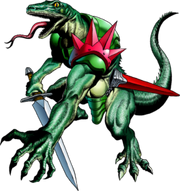
Lizalfos
are commonly identified as being related to the Dinolfos, although this is easily debatable due to the lack of information between the two species. Dairas are also a likely relative, due to the similar appearance and their use of primitive weaponry. Yet another potential relative are the Tokay, another primitive reptilian species.
Magic Sword[]
Although unconfirmed, it is possible that the Magical Sword formed the basis for the Master

Magic Sword
Sword of later games, as it is the third, final, and most powerful sword in the game. Some fans believe them to be one and the same.
Magician[]
The Magician is a character from Zelda II: The Adventure of Link. Never seen in-game, the
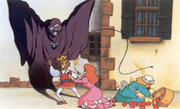
Magician is mentioned in the game's prologue. He was the court wizard to the King of Hyrule, who attempted to grasp control of the Triforce of Courage.
Carock[]
The Magician is never seen in-game, but there are pictures of him in the instruction manual for The Adventure of Link. These pictures greatly resemble artwork for Carock, the boss of the Maze Island Palace. Though nothing ever confirms this, it is possible that the two share some kind of connection.
Alter Ego of Ganon[]
While it does not state it as fact, Hyrule Historia offers the suggestion that the Magician may have been an alter ego of Ganon, much like Agahnim from A Link to the Past, or at the very least that he was working under Ganon's command, citing his persistence in learning about the secrets of the Triforce as possible evidence of this.
Possession[]
In the artwork accompanying the scene where the prince and Magician are interrogating Zelda for the location of the remaining Triforce piece, the Magician is shown to be partially merged with the prince's shadow, implying that the Magician might have possessed the prince into interrogating Zelda.
North Castle[]
It is often supposed that North Castle (which does not appear in any other game) may be the
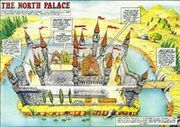
same as Hyrule Castle, as both structures have moats. However, due to the geographical location, this hypothesis is likely untrue.
Many of the timeline theories surrounding the Zelda games believe that the backstory of Zelda II took place before any of the other games. If this is correct, it may be that after Princess Zelda was placed in North Castle for the duration of her magical slumber, the royal family constructed and relocated to the building known throughout the rest of the series as Hyrule Castle.
Prince of Hyrule[]
In the artwork accompanying the scene where the prince and Magician are interrogating Zelda for
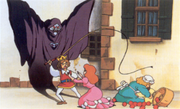
the location of the remaining Triforce piece, the Magician is shown to be partially merged with the prince's shadow, implying that the Magician might have possessed the prince into interrogating Zelda.
Princess Zelda[]
The relationship Zelda has with Link is close, possibly her closest. A popular theory among
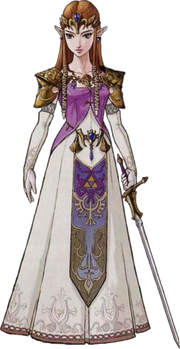
fans is that of a romantic relationship between some of the Zelda and Link characters in the Zelda series. Although never explicitly confirmed in a video game title, this theory is based on hints given in the games, interviews with the game creators, and content of the animated series, comics, and manga (although the last three are generally considered non-canonical).
One hint of a romance between Zelda and Link is given at the end of The Adventure of Link, when the awakened Princess apparently kisses Link under the falling curtain.
Some cutscenes in Ocarina of Time featuring the two together have been interpreted as signs of an attraction. While Link and Zelda are escaping Ganon's Castle, Zelda will additionally show her concern for Link by shouting out whenever he is hurt. Moreover, in the game's final scene, Zelda and Link are floating in the sky together, sharing a decidedly sentimental (if not necessarily romantic) moment where Zelda apologies for involving Link in the events of the game and seems saddened by the situation. She also stated that she will not forget the time she spent with him in the Child Timeline as shown in Majora's Mask through Link's memory.
In addition, if the Oracle games are played as sequels to each other, the ultimate ending sequence shows Zelda lightly kissing Link on the cheek. Link swoons while hearts float above the pair's heads, and Zelda looks away, blushing. In The Wind Waker, when Zelda is asked to stay in hiding in Hyrule Castle while Link restores power to the Master Sword, she waves goodbye to Link, asking him to be careful.
Spirit Tracks features several moments that can be interpreted romantically. Early in the game
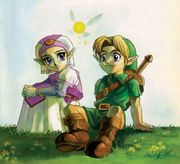
during the Graduation Ceremony, Zelda walks into the room in front of Link, who is bowing down respectfully. Link then looks up and gasps, blushing at her in amazement. He is then scolded by Chancellor Cole for raising his head without permission. Later, when Zelda's spirit is separated from her body following the first encounter with Chancellor Cole and Byrne, Link is the only one who can see her besides the Lokomos, demonstrating a clear and strong bond between himself and the Princess. After Zelda and Link defeat Byrne in the Tower of Spirits, Byrne, disbelieving, comments that he was beaten by two humans. Zelda, while still possessing a Phantom, says that when she and Link combine their strength, no one can defeat them. Link turns to her, surprised. The background turns white and Zelda's Lullaby plays as they both laugh and high-five, gazing at each other all the while. Toward the end of the game, before the final battle against Malladus, Zelda is reunited with her body, and is no longer able to levitate. Link runs underneath her to catch her as she falls, and she lands on top of him and knocks them both to the ground as well as knock Link out for a few seconds. Upon awakening, Zelda, overjoyed to have her body back, embraces Link, causing him to blush. Finally, after Malladus is defeated, Zelda and Link watch Anjean and Byrne's spirits ascend to the heavens. The camera then lowers to show Zelda and Link holding hands while Zelda's Lullaby plays in the background. After the credits, a short cut scene shows Zelda gazing at a picture of Link on the Spirit Train with her flying beside him, which she keeps on her desk. she may also wave at Link depending on his answer to a question Zelda asked before.
Skyward Sword has several noticeable romantic moments between Link and Zelda. Early in the game, Zelda wants Link to be the first to see her outfit for the Wing Ceremony. She worries over him and she does not want him to fail at becoming a knight. When Link's Crimson Loftwing is hidden by Groose, Zelda assists Link in finding his Loftwing. After Link wins the Wing Ceremony, Zelda jumps off the ledge and Link catches her almost as if she was expecting him to. She then congratulates him on winning. Afterwards, Zelda mentions that she is very happy to be atop the Statue of the Goddess with him. She also gets extremely close to him and almost implies that the two are to kiss, before she pushes him off the statue. Afterward, Zelda bashfully asks Link to go out flying which they do. She then tells Link how amazing the day was, and that she would remember it forever. At the Temple of Hylia, when Zelda states she must seal herself to keep Demise in place, she sheds tears of sadness and states before all this, she was happy just being with Link on Skyloft, demonstrating a deep level of feelings for Link. Link desperately tries to stop her and when she is sealed, Link lowers his head in sadness, showing his deep feelings for her. Much later in the game, when Link releases Zelda from her sealed state, Link runs up and catches her from falling and both of them hug and walk out smiling at each other, holding hands, before Ghirahim ruins the tender moment. During the ending, Zelda asks what Link will do now. Link sweetly smiles at her while their Loftwings fly off toward the sky, implying that he chose to stay on the Surface to live with Zelda.
A Link Between Worlds features some gossip told to Link by the Rumor Guy. He tells Link that one of the castle staff had seen Zelda sneaking off every night. When she followed her, she saw Zelda staring at the painting in Hyrule Castle depicting the Link and Zelda from A Link to the Past cuddling with each other, implying they became more intimate with each other. This also hints the Zelda in A Link Between Worlds wants to have a similar relationship with the Link of her time.
The game creators also seem to be fond of the idea of romance between the characters.[1]
Though never directly stated in-game, Shigeru Miyamoto revealed in an interview conducted by Famimaga 64 that Navi is jealous of Princess Zelda and has feelings for Link.[2]
Another less popular theory among fans is that Link and Zelda are related by blood, either as siblings or more distantly. Even though rumors to this effect started with the infamous "Save the Princess... Zelda is your... ... ..." line from A Link to the Past (later reported as a mistranslation), the theory generally revolves around the Link and Zelda from Ocarina of Time.
A possible indication of a blood relation between the two in Ocarina of Time is their physical resemblance: they both have blonde hair, blue eyes, and similar facial features. They also have similarly shaped heads. Graphics limitations could be responsible for some of this similarity, however. Certain dialogue could also be perceived as implying a blood relation: the ghost Sharp comments that Link reminds him of Zelda, and that Link "may have some connection with the Royal Family".[3] Link's connection to the Royal Family is highlighted throughout the game, with Link often playing Zelda's Lullaby to verify it. The fact that Impa agrees to teach a strange boy a song only Royal Family members are allowed to know could also be interpreted as a hint at Link's blood relation to Hyrule's Royal Family. [4]
Additionally, Zelda seems to recognize Link's name upon their first meeting.[5] This could be attributed to her prophetic abilities, although the boy in her dreams seemed to be a largely abstract figure, with no defining traits aside from the presence of a guardian Fairy and a Spiritual Stone. This line of dialogue has often been regarded as a sign that the two have met before, although this could only have occurred when Link was a baby per the Deku Tree Sprout's account of Link's coming to Kokiri Forest. It is also worth noting that while the King of Hyrule is clearly identified as Zelda's father, no mention is made of a Queen. Meanwhile, Link's mother is stated to have died shortly after reaching the forest, but no information is given concerning his father. Given these facts, it is possible that Zelda and Link share the same parents, making them siblings.
Spectacle Rock[]
Spectacle Rock, located at the summit of Death Mountain, presumably appears as an island on the
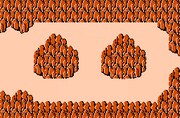
Great Sea known as Spectacle Island. The Great Sea, the country in which the game is set, was in truth created when Hyrule was flooded by the Gods. Spectacle Rock, the very top of the tall, tall Death Mountain, is the only surviving landmark of that area. However, there is a conflicting theory that Dragon Roost
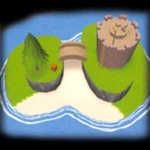
Island is Death Mountain, due to the ring of smoke seen on Link's first visit there and the fact that it is a volcano, as well as the fact that it is taller than all other Islands in the game.
Split Timeline[]
It is speculated by some that alternate worlds such as the Twilight Realm and Termina may be unaffected by the timeline split. However, while these two realms are alternate dimensions, there is no evidence to support the idea that they exist outside of linear time. Both realms have demonstrated the ability to receive beings from the Child Timeline and return them to the Child Timeline when they exit back into Hyrule. There is no reason to believe that these two realms would only exist as a single timeline, or that they could "prioritize" inputs from one timeline, and later output these into both the timelines.
In addition, the renowned Youtube show, Game Theory, dismissed the Zelda Timeline, particularly the Defeat Timeline (in where Link fails on his quest) on the grounds that "the hero cannot be simultaneously victorious and defeated". Elaborating, he explained that with Link defeating Gannondorf, two perfectly possible timelines are created; However if Link dies at any point in his journey another separate timeline is created. Explaining that the only way for all 3 timelines to exist is the Many Worlds Theory (the theory that all possible pasts and futures exist in separate timelines). [1]
Timeline[]
"Just a Legend" Theory[]
Some fans say that the chronology of the series should not be so rigid. Just as real-world legends are retold with different variations (e.g. the flood), each game could merely be a different retelling of the same story. With each advancement in videogame hardware and the ever-changing desires of the consumer, the base story of Link saving Princess Zelda from Ganon and recovering the Triforce is embellished, modified, and changed outright. Just like any other legend, The Legend of Zelda changes as it is retold through the years. Despite the fact that Aonuma and Miyamoto have confirmed the existence of a timeline, this remains a popular theory.
